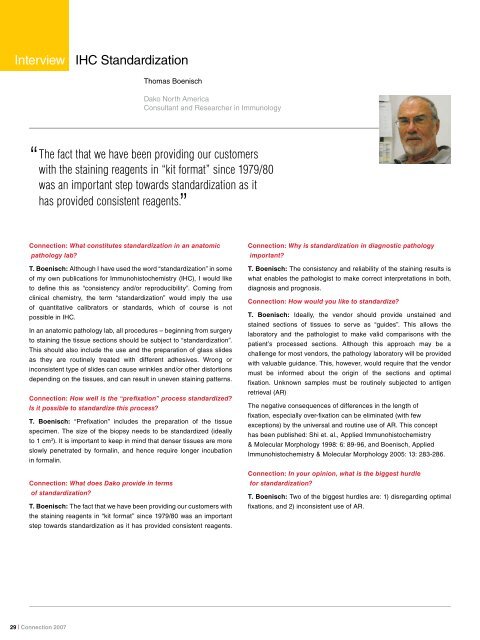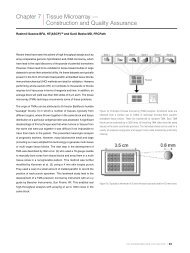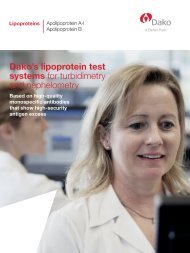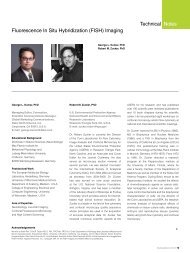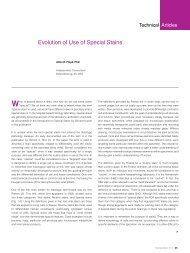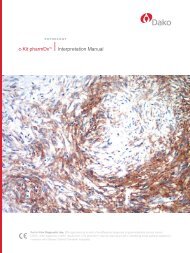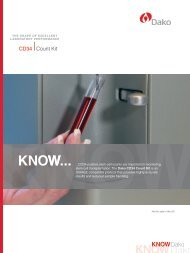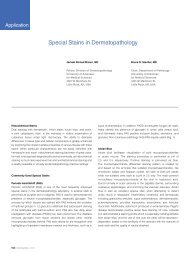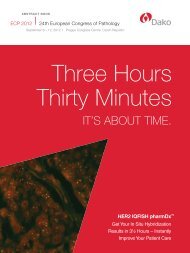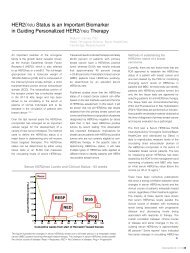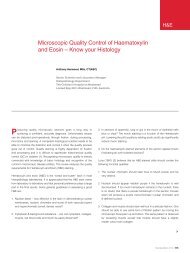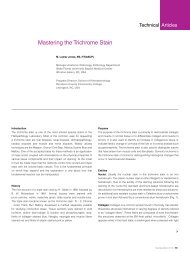Interview IHC Standardization - Dako
Interview IHC Standardization - Dako
Interview IHC Standardization - Dako
You also want an ePaper? Increase the reach of your titles
YUMPU automatically turns print PDFs into web optimized ePapers that Google loves.
<strong>Interview</strong> <strong>IHC</strong> <strong>Standardization</strong><br />
Thomas Boenisch<br />
<strong>Dako</strong> North America<br />
Consultant and Researcher in Immunology<br />
The fact that we have been providing our customers<br />
“<br />
with the staining reagents in “kit format” since 1979/80<br />
was an important step towards standardization as it<br />
has provided consistent reagents. ”<br />
Connection: What constitutes standardization in an anatomic<br />
pathology lab?<br />
T. Boenisch: Although I have used the word “standardization” in some<br />
of my own publications for Immunohistochemistry (<strong>IHC</strong>), I would like<br />
to define this as “consistency and/or reproducibility”. Coming from<br />
clinical chemistry, the term “standardization” would imply the use<br />
of quantitative calibrators or standards, which of course is not<br />
possible in <strong>IHC</strong>.<br />
In an anatomic pathology lab, all procedures – beginning from surgery<br />
to staining the tissue sections should be subject to “standardization”.<br />
This should also include the use and the preparation of glass slides<br />
as they are routinely treated with different adhesives. Wrong or<br />
inconsistent type of slides can cause wrinkles and/or other distortions<br />
depending on the tissues, and can result in uneven staining patterns.<br />
Connection: How well is the “prefixation” process standardized?<br />
Is it possible to standardize this process?<br />
T. Boenisch: “Prefixation” includes the preparation of the tissue<br />
specimen. The size of the biopsy needs to be standardized (ideally<br />
to 1 cm 3 ). It is important to keep in mind that denser tissues are more<br />
slowly penetrated by formalin, and hence require longer incubation<br />
in formalin.<br />
Connection: What does <strong>Dako</strong> provide in terms<br />
of standardization?<br />
T. Boenisch: The fact that we have been providing our customers with<br />
the staining reagents in “kit format” since 1979/80 was an important<br />
step towards standardization as it has provided consistent reagents.<br />
Connection: Why is standardization in diagnostic pathology<br />
important?<br />
T. Boenisch: The consistency and reliability of the staining results is<br />
what enables the pathologist to make correct interpretations in both,<br />
diagnosis and prognosis.<br />
Connection: How would you like to standardize?<br />
T. Boenisch: Ideally, the vendor should provide unstained and<br />
stained sections of tissues to serve as “guides”. This allows the<br />
laboratory and the pathologist to make valid comparisons with the<br />
patient’s processed sections. Although this approach may be a<br />
challenge for most vendors, the pathology laboratory will be provided<br />
with valuable guidance. This, however, would require that the vendor<br />
must be informed about the origin of the sections and optimal<br />
fixation. Unknown samples must be routinely subjected to antigen<br />
retrieval (AR)<br />
The negative consequences of differences in the length of<br />
fixation, especially over-fixation can be eliminated (with few<br />
exceptions) by the universal and routine use of AR. This concept<br />
has been published: Shi et. al., Applied Immunohistochemistry<br />
& Molecular Morphology 1998: 6: 89-96, and Boenisch, Applied<br />
Immunohistochemistry & Molecular Morphology 2005: 13: 283-286.<br />
Connection: In your opinion, what is the biggest hurdle<br />
for standardization?<br />
T. Boenisch: Two of the biggest hurdles are: 1) disregarding optimal<br />
fixations, and 2) inconsistent use of AR.<br />
29 | Connection 2007
Connection: Which product of <strong>Dako</strong> best personifies the<br />
standardization process and why?<br />
T. Boenisch: Kits and AR reagents best personify standardization as<br />
they provide reagents and tissues of nearly uniform and comparable<br />
quality regardless of the inconsistencies created by uncontrolled<br />
fixation.<br />
Connection: Would procedural simplification aid standardization?<br />
T. Boenisch: Yes. I have shown in my recent publication (Boenisch, T.<br />
Pre-treatment for Immunohistochemical Staining Simplified. Applied<br />
Immunohistochemistry & Molecular Morphology. 15(2):208-212, June<br />
2007) that this is possible. Here I compared several procedures for the<br />
pre-treatment of formalin-fixed and paraffin-embedded tissue sections<br />
and showed that a simpler approach than what is routinely used today<br />
is possible.<br />
Connection: Can we have a standardized procedure to interpret<br />
<strong>IHC</strong> assays<br />
T. Boenisch: Yes. For instance, when interpretations are based on<br />
the number of stained cells or nuclei, but less so when the intensity of<br />
staining is relied on.<br />
Connection: How has <strong>Dako</strong> contributed to <strong>IHC</strong> standardization?<br />
How is it involved in the development of <strong>IHC</strong> products?<br />
T. Boenisch: <strong>Dako</strong> was the first vendor to commercialize the “kit<br />
format” for <strong>IHC</strong> in 1979/80. During the following 28 years <strong>Dako</strong> has<br />
supported consistency of staining through this step.<br />
Connection: How do you assure that <strong>Dako</strong>’s reagents work<br />
on a variety of patient samples-for instance, patients from<br />
different countries?<br />
T. Boenisch: Use of our <strong>IHC</strong> kits has consistently given reproducible<br />
results in all parts of the world since we started making them. Also, we<br />
have always consistently subscribed to the principles and approaches<br />
outlined by the Ad-Hoc Committee on Immunohistochemistry<br />
<strong>Standardization</strong>. Goldstein, Neal S. MD; Hewitt, Stephen M. MD,<br />
PhD; Taylor, Clive R. MD, DPhil; Yaziji, Hadi MD; Hicks, David G.<br />
MD; Members of Ad-Hoc Committee On Immunohistochemistry<br />
<strong>Standardization</strong>. Applied Immunohistochemistry & Molecular<br />
Morphology. 15(2):124-133, June 2007. With due modesty, I would<br />
like to point out that my work in this field has been quoted repeatedly.<br />
Connection: What is validation and how does it fit<br />
into standardization?<br />
T. Boenisch: “<strong>Standardization</strong>” of <strong>IHC</strong> requires the correct application/<br />
use of recommended procedures, including the simultaneous<br />
staining of provided controls. And, I would like to emphasize, by<br />
the documented benefits of the routine use of AR procedures for<br />
all antigens (Boenisch, Applied Immunohistochemistry & Molecular<br />
Morphology 2005: 13: 283-286).<br />
Connection: You were one of four who started <strong>Dako</strong> in<br />
Santa Barbara, CA in 1979. You retired in 1993, but you keep<br />
publishing in peer-reviewed journals – including your recent<br />
Applied Immunohistochemistry & Molecular Morphology<br />
paper in June of 2007. How have you kept up with the changes<br />
in the industry, and what do you do in your spare time.<br />
T. Boenisch: My continuing interest in <strong>IHC</strong> is largely based on<br />
my general interest in protein chemistry. I have kept abreast of the<br />
many changes by reading new publications, being a member of the<br />
“Committee for the <strong>Standardization</strong> of <strong>IHC</strong>” and by many “hands-on”<br />
experiments in <strong>Dako</strong>’s R&D department.<br />
In my spare time, I engage in oil painting and participate in the Santa<br />
Barbara Art Show on Sundays; listening to the classical music and<br />
opera (remember, I am from Vienna, Austria), and then of course<br />
growing orchids and succulents.<br />
Contact Information:<br />
Name Thomas Boenisch<br />
Title Consultant and Researcher in Immunology<br />
Company <strong>Dako</strong> North America<br />
Address 6392 Via Real | Carpinteria | CA 93013<br />
Country Austria/ USA<br />
Email tomboenisch@cox.net<br />
Education Diploma in Engineering. Vienna, Austria.<br />
Experience & Responsibilities<br />
Director of Immunochemistry and VP. <strong>Dako</strong> Corporation,<br />
Santa Barbara, CA, USA 1979-93<br />
Member of the Subcommittee: Quality Assurance for<br />
Immunohistochemistry. Clinical and Laboratory Standards Institute,<br />
Wayne, PA, USA 2005-2007.<br />
Connection 2007 | 30


